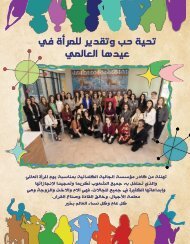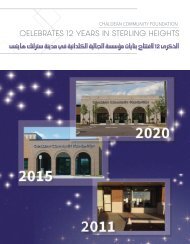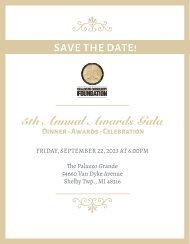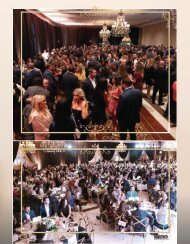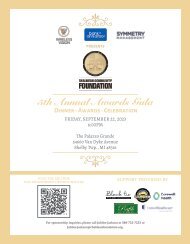Create successful ePaper yourself
Turn your PDF publications into a flip-book with our unique Google optimized e-Paper software.
From left: Habib Hannona in a 1961 portrait; Working in college, 1965; Habib Hannona 2022. Below: ‘My Mother’ painting by Habib Hannona, 1986.<br />
tion Contracting Company. At Eridu,<br />
he invited his best friends to join<br />
him and together, they implemented<br />
many projects throughout Iraq (1974-<br />
1984) and Kuwait (1985-1990). Habib<br />
lived in Kuwait from 1984 until Iraq<br />
invaded in 1990.<br />
The Gulf War of 1991 was a turning<br />
point and a critical new step in<br />
his life. In 1991, he left Iraq with his<br />
family to move to the United States<br />
of America. The family lived in San<br />
Diego, California until 1995, before<br />
moving to Detroit, Michigan.<br />
Habib the Artist<br />
There is no denying that Habib was a<br />
trailblazer in his early days; he loves to<br />
talk about his artistic interest and reflect<br />
on his pioneering work of drawings.<br />
“I started since fifth grade…and<br />
was influenced by an art teacher (Hazem<br />
Afendi) who encouraged me and<br />
allowed my talent to grow and develop<br />
through several years of practice,”<br />
Habib remembers.<br />
“My first artistic achievement was<br />
drawing a large oil painting representing<br />
‘Mar Gewargees,’ painted at<br />
the request of the Khor-Bishop of Mar<br />
Adday in Karemlash in 1961. I was 18<br />
years old.”<br />
Throughout his artistic career,<br />
Habib completed more than fifty oil<br />
paintings, plus dozens of sketches,<br />
watercolors, and drawings on glass.<br />
According to Habib, his most important<br />
oil paintings are “On the Calvary”<br />
and “Mother.”<br />
The latter was a large painting<br />
that he completed during his stay at<br />
the University of Al-Hikma. The piece<br />
was ultimately donated to the University<br />
Church. After the nationalization<br />
of Al-Hikma University in 1968, and<br />
subsequent looting it was unfortunately<br />
stolen and went missing. After<br />
a 3-year search, the painting was located<br />
and Habib tried to purchase it<br />
back for 1,000 Iraqi Dinar in 1971 from<br />
a collector but was unsuccessful.<br />
Habib did not study art or receive<br />
formal training. He benefited from<br />
the advice of many connoisseurs who<br />
watched over his work and from his<br />
visits to art galleries and museums,<br />
in Iraq and Europe. These activities<br />
helped him develop his artistic vision<br />
and become acquainted with the major<br />
art schools in the world.<br />
His artistic passion and quest for<br />
exploring the world of arts and architecture<br />
made him travel extensively.<br />
He has visited most of the countries<br />
of Eastern and Western Europe many<br />
times; for tourism, knowledge, to visit<br />
museums, and search for historical<br />
sources.<br />
Around the world in 80 days<br />
Traveling is still a favorite activity<br />
whenever his circumstances permit.<br />
In 1984, Habib went on a journey<br />
around the world in 80 days, inspired<br />
by the famous novel of Jules Verne:<br />
“Around the World in 80 Days.”<br />
Habib explained his extreme efforts<br />
to travel, “At that time, the<br />
booking (flights and hotels) and the<br />
planning was not easy; there was<br />
no internet at that time, no smart<br />
phones, no Google or GPS.”<br />
He gathered all the visas from the<br />
countries which he planned to visit<br />
from their consulates in Kuwait, except<br />
the Consulate of United States of<br />
America.<br />
Here is that story:<br />
“This is what happened. On December<br />
12, 1983, I went to the US Consulate<br />
in Kuwait around 8:00 – 8:30 AM to apply<br />
for a visa. While I was in the Consulate<br />
lobby waiting my turn to be called<br />
for submitting my application, looking<br />
through the window, I saw a big ruck<br />
hit the entrance gate and then a big<br />
explosion happened. In moments, the<br />
entire Consulate building collapsed on<br />
our heads.”<br />
Habib’s recounting of the terrorist<br />
attack continues: “I was bleeding<br />
in different spots - my head and my<br />
hands, etc. I lost my bag, my papers,<br />
and my passport. It is hard to explain<br />
my situation at that moment -life<br />
threatening fear. Thanks God, I made<br />
it outside through the rubble, while<br />
I am bleeding. I have climbed on the<br />
exterior wall and thrown myself to the<br />
ground.<br />
“After a few days, I went back to<br />
the US Consulate in Kuwait to look for<br />
my papers. The Consulate was closed,<br />
but they allowed me to go in because<br />
I was one of the victims of the terrorist<br />
attack. The Consulate personnel gave<br />
me my papers and told me that, “The<br />
United States Consulate in Kuwait is<br />
closed for a while, but you can get the<br />
visa from the USA Embassy – Consular<br />
Section in London. Your name<br />
is there.<br />
“That terrorist act has affected my<br />
life for long time.”<br />
Habib’s journey around the world<br />
began on Friday December 23, 1983,<br />
travelling from Kuwait going west<br />
to Istanbul-Turkey. He then headed<br />
CULTURE continued on page 34<br />
<strong>MARCH</strong> <strong>2023</strong> CHALDEAN NEWS 33









